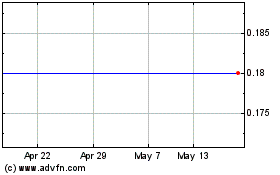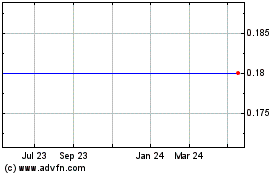2 Summary of significant accounting policies
The following significant accounting policies are in conformity
with accounting principles generally accepted in the United States
of America ("US GAAP"). The Company applies the provisions of
Financial Accounting Standards Board ("FASB") Accounting Standard
Codification ("ASC") 946-10, Financial Services - Investment
Companies (formerly the AICPA Audit and Accounting Guide for
Investment Companies) (the "Guide"). Such policies are consistently
followed by the Company in the preparation of its consolidated
financial statements.
(a) Principles of consolidation
These consolidated financial statements include the financial
statements of the Company and its subsidiaries (collectively, the
"Fund"). Subsidiaries are fully consolidated from the date on which
control is transferred to the Fund and deconsolidated from the date
that control ceases. Inter-company transactions between group
companies are eliminated upon consolidation.
The Company uses wholly and partially owned special purpose
vehicles ("SPVs") to hold and transact in certain investments. The
Company's policy is to consolidate, as appropriate, those SPVs in
which the Company has control over significant operating, financial
or investing decisions of the entity.
Except when an operating company provides services to the
Company, investment in an operating company is carried at fair
value (refer to Note 2(c) below for fair value measurement).
(b) Use of estimates
The preparation of consolidated financial statements in
conformity with US GAAP requires the Fund's management to make
estimates and assumptions that affect the reported value of assets
and liabilities and disclosures of contingent assets and
liabilities as at 31 December 2011 and the reported amounts of
income and expenses for the year then ended. The areas involving a
higher degree of judgment or complexity, or areas where assumptions
and estimates are significant to the financial statements are
disclosed in Note 2(m).
(c) Investments
The Fund holds investment securities which are unlisted and have
limited marketability. The Fund also engages in secured lending
transactions consisting of repurchase agreements and other secured
borrowings.
(i) Recognition and derecognition
Regular purchase and sale of investments are accounted for on
the trade date, the date the trade is executed. Costs used in
determining realized gains and losses on the disposal of
investments are based on the specific identification method for
unlisted or unquoted investments. Cost includes legal and due
diligence fees associated with the acquisition of investments.
Transfer of investments is accounted for as a sale when the Fund
has relinquished control over the transferred assets. Any realized
gains and losses from investments are recognized in the
consolidated statement of operations.
(ii) Fair value measurement
The Fund is an investment company under the Guide. As a result,
the Fund records and re-measures its investments on the
consolidated statement of assets and liabilities at fair value,
with unrealized gains and losses resulting from changes in fair
value recognized in the consolidated statement of operations.
Fair value is the amount that would be received to dispose of
the investments in an orderly transaction between market
participants at the measurement date, i.e. the exit price. Fair
value of investments is determined by the Valuation Committee of
the Fund, which is established by the Investment Manager and the
Board of Directors.
The fair value of unlisted or unquoted securities are based on
the Fund's valuation models, including earnings multiples (based on
the budgeted earnings or historical earnings of the issuer and
earnings multiples of comparable listed companies) and discounted
cash flows. The Valuation Committee also considers the relevant
developments since acquisition of the investments, the original
transaction price, recent transactions in the same or similar
instruments, completed third-party transactions in comparable
instruments, reliable indicative offers from potential buyers and
rights in connection with realization. It adjusts the model as
necessary for factors such as non-maintainable earnings, tax risk,
growth stage, and cash traps. Cross-checks of primary techniques
are made against other secondary valuation techniques.
In determining fair valuation of certain unlisted securities,
the Valuation Committee uses as reference valuations made by
independent valuers which rely on the financial data of investees
and on estimates made by the management of the investee companies
as to the effect of future developments. The independent valuers
also assist in the selection of valuation techniques and models.
Loans receivable are recorded at fair value in accordance with the
guidance set forth in Note 4, and the valuation techniques applied
usually takes into account the estimated future cash flows,
liquidity, credit, market and interest rate factors. However, there
are inherent limitations in any valuation technique due to the lack
of observable inputs. Estimated fair value may differ significantly
from the value that would have been used had a readily available
market for such investments existed and these differences could be
material to the financial statements. Additional information about
the level of market observability associated with investments
carried at fair value are disclosed in Note 4 below.
(d) Other receivables and payables
Other receivables and payables are initially measured at fair
value and subsequently measured at amortized cost.
(e) Cash and cash equivalents
Cash represents cash at banks and does not include restricted
cash such as fixed deposits pledged as security for the bank loans.
Cash equivalents are defined as short-term, highly liquid
investments which mature within three months or less of the date of
purchase.
(f) Restricted cash
The Fund classifies cash that is restricted for specific
purposes and is unavailable for general use as restricted cash.
(g) Bank loans
Bank loans are initially recognized at fair value, net of
transaction costs incurred and subsequently stated at amortized
cost. Any difference between the proceeds (net of transaction
costs) and the redemption value is recognized in the consolidated
statement of operations over the period of the borrowing using the
effective interest method.
(h) Share capital
Ordinary shares are classified as equity. Where any group
company purchases the Company's equity share capital, the
consideration paid is deducted from equity until the shares are
cancelled or reissued. Where such ordinary shares are subsequently
reissued, any consideration received is included in equity.
(i) Foreign currency translation
The books and records of the Fund are maintained in United
States Dollars ("US$"), which is also the functional currency.
Assets and liabilities, both monetary and non-monetary, denominated
in foreign currencies are translated into US$ at year-end exchange
rates, while income and expenses are translated at the exchange
rates in effect during the year.
Gains and losses attributed to changes in the value of foreign
currencies for investments, cash balances and other assets and
liabilities are reported as foreign exchange gain and loss.
(j) Taxation
The Fund may be subject to taxes imposed in jurisdictions in
which it invests and operates. Such taxes are generally based on
income and gains earned. Taxes are accrued on investment income,
realized gains, and unrealized gains, as appropriate, when the
income and gains are earned. The Fund accrues for liabilities
relating to uncertain tax positions only when such liabilities are
probable and can be reasonably estimated in accordance with the
authoritative guidance contained in ASC 740 Income Taxes (formerly,
FASB Interpretation No.48, accounting for uncertainty in Income
Taxes) described in Note 10.
The Fund files tax returns as prescribed by the tax laws of the
jurisdictions in which it operates. The Fund uses the asset and
liability method to provide income taxes on all transactions
recorded in the consolidated financial statements. This method
requires that income taxes reflect the expected future tax
consequences of temporary differences between carrying amounts of
assets or liabilities for book and tax purposes. Accordingly, a
deferred tax asset or liability for each temporary difference is
determined based on the tax rates that the Fund expects to be in
effect when the underlying items of income and expense are
realized.
(k) Recognition of income and expenses
Interest income on bank balances is accrued as earned using the
effective interest method.
Dividend income is recognized on the ex-dividend date and is
recorded net of withholding taxes where applicable.
Consulting income is recognized in accounting period in which
the services are rendered.
Expenses are recorded on an accrual basis. Provision of deferred
expenses are made as if the investments are liquidated and realised
at value stated as the year-end.
(l) Subsequent events
The Fund discloses events that occur after the balance sheet
date but before the financial statements are issued or are
available to be issued. See Note 16, Subsequent Events, for further
discussion.
(m) Critical accounting estimate and assumptions
Estimates and judgements are continually evaluated and are based
on historical experience and other factors, including expectations
of future events that are believed to be reasonable under the
circumstances. The resulting accounting estimates will, by
definition, seldom equal the related actual results. The estimates
and assumptions that have a significant risk of causing a material
adjustment to the carrying amounts of assets and liabilities within
the next financial year are addressed below.
(i) Fair value of investments
Pacific Alliance China L... (LSE:PACL)
Historical Stock Chart
From Jun 2024 to Jul 2024

Pacific Alliance China L... (LSE:PACL)
Historical Stock Chart
From Jul 2023 to Jul 2024
